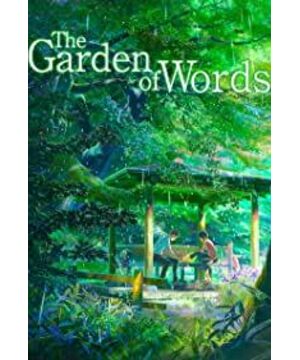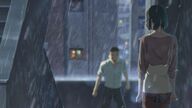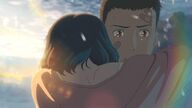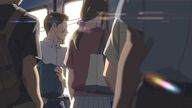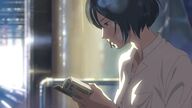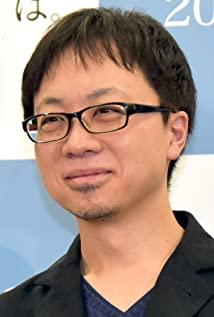spoiler , anyway, everyone is not watching the plot ==) The shot I am referring to is the 20 seconds of 00:20:21-00:20:41. The picture is a middle shot. The boy is measuring the teacher's feet. The teacher is standing on the bench, as if talking to the boy and saying to himself: "I, I can't go on smoothly. I don't know when to start." "Work." Aspect?" "Yes, but not all." The boy lowered his head, focusing on the teacher's feet, and started the inner monologue used by Xin Haicheng: "I almost know nothing about her, occupation, age, and What annoyance... (camera switch, slowly zoom to the distant view, the lyrical content will not be repeated here)"
And these 20 seconds can be divided into two 10 seconds before and after, the first 10 seconds is a simple conversation between the two on rainy days, starting with the boy lowering his head After 10 seconds, the boy's inner monologue began to enter the boy's inner monologue. The rain faded and the sunlight quickly shone out. At the same time, the focus began to narrow. The two figures became blurred, and finally focused on a branch that was placed in the foreground and covered with rain.
I think these 20 seconds tell a lot of things. It not only pushes the early stage of the film to a climax, but also plays the role of a turning point in the plot, summarizing and suggesting the plot. Before this, it was a straightforward narrative of the process of the two people getting to know each other and forming feelings during the rainy season; this process reached a climax at the moment the boy touched the teacher’s feet, that is, this 20 seconds; after this, the two of them started after the rainy season. Life, the film's rhythm has changed, the plot has taken a turn for the worse, and the director's "revelation" process has begun. From this point of view, the importance of this lens is of course self-evident, and we have enough reasons to infer that Xin Haicheng has worked hard with this lens. Let me start talking about my understanding.
The first is the position of the two in the composition of the picture. We know that in the usual framing technique of the middle shot, most of the characters as the center are in a parallel or equal relationship. In dialogue composition, the relationship between the two is equal. In this shot, the compositional relationship between the two clearly breaks the conventional technique-from the perspective of head-up, a clearly unbalanced relationship is constructed. This relationship is embodied as unstable in composition, but in terms of character status. Reflected as a kind of inequality. And this inequality is precisely the status relationship between the boy and the teacher reflected in the film: the teacher is superior to the boy in terms of age, experience, and perspective. Therefore, when the two exchanged, it was the boy looking up and the teacher looking down. In summary, here, the composition itself symbolizes a relationship of status.
Secondly, when there is communication between roles in two positions, the connection point between the two is particularly important. A kind of inertial thinking forces us to discover that it is an intersection between these two positions, a connection point between the two, that makes the two communicate. And this connection point, also explained very clearly in this shot, is the shoe. It can be explained from the perspective of composition alone. It is the boy holding the teacher's foot. This physical touch is extended to the friction of the soul.
Again, you must pay attention to the changes in the weather and the focal length of the lens in the next 10 seconds. I said that these 20 seconds are like the epitome of the entire film, with the boy lowering his head at 00:20:31 as the boundary, and the 10 seconds before and after the first and the next 10 seconds are respectively miniaturized the upper and lower parts of the entire film with this 20 seconds as the boundary. In the last 10 seconds, as the part of "opening down", it naturally provided a hint and pavement for the following plot.
First, let’s talk about changes in the weather. This is easier to understand, that is, when the boy’s eyes change from looking up at the teacher to looking down at his feet, that is, when the plot changes, the weather in the following text will be sunny. This is a simple hint.
Then talk about the change of focal length. I think this zoom is very meaningful. After zooming, the rain-stained branch is highlighted. Its subtext is to tell the viewer, don’t forget, there is actually a connection point between the two, which is rain. And I think the most ingenious thing is the treatment of this branch. It has two functions: First, as mentioned above, it is a hint of a sunny day in the next 10 seconds, and when the weather has cleared, the director wants to ask The viewer emphasizes the importance of the "rain" element in the film, what should be done? So this branch appeared, and the director used raindrops on the branch to replace the element of "rain". The second role follows closely here. What does the director want to emphasize about the "rain" element? So this branch once again separated the two people's domain from the composition, and became the line that lay between the two and connect the two together.
This zoom lens seems to say to the viewer: It is rain, which connects the fate of the two; and if the rainy season passes, how will the relationship between the two change?
Finally, this scene has a reference later in the article, which is the scene where the last two completely release their emotions on the stairs during a rainstorm. Have you noticed that when the teacher catches up with the boy, the boy can no longer restrain his emotions and yells at the teacher desperately, while the teacher is just standing on the stairs and crying silently, the relationship between the two is still unequal. It's still a middle shot, it's still a head-up, it's still an uneven composition, and it's still an unequal status. The source of all this sense of distance actually existed until the teacher could no longer restrain him and rushed down from the steps to hug the boy. This sense of hierarchy disappeared completely; until at this moment, the path between the two The gully was completely eliminated, and the screen was zoomed in, returning to the familiar half-length dialogue scene. In fact, by this time, the following plot is no longer important. The mutual reference of these two shots has already explained everything, and everything after that is unnecessary.
The film ends just right in this place, at least it is inefficient, and at most it is procrastinated. Only at this moment can the play be sung intact and vividly.
View more about The Garden of Words reviews


